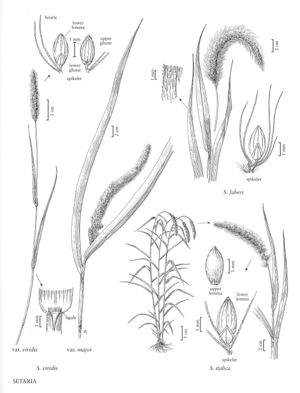Difference between revisions of "Setaria italica"
FNA>Volume Importer |
imported>Volume Importer |
||
| (2 intermediate revisions by the same user not shown) | |||
| Line 4: | Line 4: | ||
|publications= | |publications= | ||
|common_names=Foxtail millet;Setaire italienne;Setaire d'italie;Millet des oiseaux | |common_names=Foxtail millet;Setaire italienne;Setaire d'italie;Millet des oiseaux | ||
| + | |special_status={{Treatment/ID/Special_status | ||
| + | |code=I | ||
| + | |label=Introduced | ||
| + | }} | ||
|basionyms= | |basionyms= | ||
|synonyms={{Treatment/ID/Synonym | |synonyms={{Treatment/ID/Synonym | ||
| Line 24: | Line 28: | ||
-->{{Treatment/Body | -->{{Treatment/Body | ||
| − | |distribution=Conn.;N.J.;N.Y.;Wash.;Del.;D.C;Wis.;W.Va.;Mass.;Maine;N.H.;R.I.;Vt.;Fla.;Wyo.;N.Mex.;Tex.;La.;N.C.;Tenn.;Pa.;Va.;Colo.;Virgin Islands;Calif.;Ala.;Kans.;N.Dak.;Nebr.;Okla.;S.Dak.;Mont.;Oreg.;Ark.;Ill.;Ga.;Ind.;Iowa;Ariz.;Md.;Alta.;B.C.;Man.;N.B.;N.S.;Ont.;Que.;Ohio;Mo.;Minn.;Mich.;Miss.;S.C.;Ky. | + | |distribution=Conn.;N.J.;N.Y.;Wash.;Del.;D.C.;Wis.;W.Va.;Mass.;Maine;N.H.;R.I.;Vt.;Fla.;Wyo.;N.Mex.;Tex.;La.;N.C.;Tenn.;Pa.;Va.;Colo.;Virgin Islands;Calif.;Ala.;Kans.;N.Dak.;Nebr.;Okla.;S.Dak.;Mont.;Oreg.;Ark.;Ill.;Ga.;Ind.;Iowa;Ariz.;Md.;Alta.;B.C.;Man.;N.B.;N.S.;Ont.;Que.;Ohio;Mo.;Minn.;Mich.;Miss.;S.C.;Ky. |
|discussion=<p><i>Setaria italica</i> was cultivated in China as early as 2700 B.C. and during the Stone Age in Europe. Nowadays it is grown mostly for hay or as a pasture grass, but it has been used as a substitute for rice in northern China. It is sometimes cultivated in North America, but it is better known as a weed in moist ditches, mostly in the northeastern United States. It is closely related to <i>S. viridis</i>, differing in the longer (3 mm) spikelets and smooth, shiny upper florets which readily disarticulate above the lower florets. It exhibits considerable variation in seed and bristle color, bristle length, and panicle shape. Using these characters, Hubbard (1915) recognized several infraspecific taxa; they are not treated here.</p> | |discussion=<p><i>Setaria italica</i> was cultivated in China as early as 2700 B.C. and during the Stone Age in Europe. Nowadays it is grown mostly for hay or as a pasture grass, but it has been used as a substitute for rice in northern China. It is sometimes cultivated in North America, but it is better known as a weed in moist ditches, mostly in the northeastern United States. It is closely related to <i>S. viridis</i>, differing in the longer (3 mm) spikelets and smooth, shiny upper florets which readily disarticulate above the lower florets. It exhibits considerable variation in seed and bristle color, bristle length, and panicle shape. Using these characters, Hubbard (1915) recognized several infraspecific taxa; they are not treated here.</p> | ||
|tables= | |tables= | ||
| Line 42: | Line 46: | ||
|illustrator=Linda A. Vorobik;Annaliese Miller | |illustrator=Linda A. Vorobik;Annaliese Miller | ||
|illustration copyright=Utah State University | |illustration copyright=Utah State University | ||
| − | |distribution=Conn.;N.J.;N.Y.;Wash.;Del.;D.C;Wis.;W.Va.;Mass.;Maine;N.H.;R.I.;Vt.;Fla.;Wyo.;N.Mex.;Tex.;La.;N.C.;Tenn.;Pa.;Va.;Colo.;Virgin Islands;Calif.;Ala.;Kans.;N.Dak.;Nebr.;Okla.;S.Dak.;Mont.;Oreg.;Ark.;Ill.;Ga.;Ind.;Iowa;Ariz.;Md.;Alta.;B.C.;Man.;N.B.;N.S.;Ont.;Que.;Ohio;Mo.;Minn.;Mich.;Miss.;S.C.;Ky. | + | |distribution=Conn.;N.J.;N.Y.;Wash.;Del.;D.C.;Wis.;W.Va.;Mass.;Maine;N.H.;R.I.;Vt.;Fla.;Wyo.;N.Mex.;Tex.;La.;N.C.;Tenn.;Pa.;Va.;Colo.;Virgin Islands;Calif.;Ala.;Kans.;N.Dak.;Nebr.;Okla.;S.Dak.;Mont.;Oreg.;Ark.;Ill.;Ga.;Ind.;Iowa;Ariz.;Md.;Alta.;B.C.;Man.;N.B.;N.S.;Ont.;Que.;Ohio;Mo.;Minn.;Mich.;Miss.;S.C.;Ky. |
|reference=None | |reference=None | ||
|publication title= | |publication title= | ||
|publication year= | |publication year= | ||
| − | |special status= | + | |special status=Introduced |
| − | |source xml=https:// | + | |source xml=https://bitbucket.org/aafc-mbb/fna-data-curation/src/200273ad09963decb8fc72550212de541d86569d/coarse_grained_fna_xml/V25/V25_1421.xml |
|subfamily=Poaceae subfam. Panicoideae | |subfamily=Poaceae subfam. Panicoideae | ||
|tribe=Poaceae tribe Paniceae | |tribe=Poaceae tribe Paniceae | ||
Latest revision as of 17:57, 11 May 2021
Plants annual. Culms 10-100 cm. Sheaths mostly glabrous, margins sparsely ciliate; ligules 1-2 mm; blades to 20 cm long, 1-3 cm wide, flat, scabrous. Panicles 8-30 cm, dense, spikelike, occasionally lobed below; rachises hispid to villous; bristles 1-3, to 12 mm, tawny or purple. Spikelets about 3 mm, disarticulating between the lower and upper florets. Lower glumes 3-veined; upper glumes 5-7-veined; lower paleas absent or 1/2 as long as the lower lemmas; upper lemmas very finely and transversely rugose to smooth and shiny, exposed at maturity. 2n = 18.
Distribution
Conn., N.J., N.Y., Wash., Del., D.C., Wis., W.Va., Mass., Maine, N.H., R.I., Vt., Fla., Wyo., N.Mex., Tex., La., N.C., Tenn., Pa., Va., Colo., Virgin Islands, Calif., Ala., Kans., N.Dak., Nebr., Okla., S.Dak., Mont., Oreg., Ark., Ill., Ga., Ind., Iowa, Ariz., Md., Alta., B.C., Man., N.B., N.S., Ont., Que., Ohio, Mo., Minn., Mich., Miss., S.C., Ky.
Discussion
Setaria italica was cultivated in China as early as 2700 B.C. and during the Stone Age in Europe. Nowadays it is grown mostly for hay or as a pasture grass, but it has been used as a substitute for rice in northern China. It is sometimes cultivated in North America, but it is better known as a weed in moist ditches, mostly in the northeastern United States. It is closely related to S. viridis, differing in the longer (3 mm) spikelets and smooth, shiny upper florets which readily disarticulate above the lower florets. It exhibits considerable variation in seed and bristle color, bristle length, and panicle shape. Using these characters, Hubbard (1915) recognized several infraspecific taxa; they are not treated here.
Selected References
None.
